RNA Sequences or Structures Can Control Gene Expression Levels
The most direct way of controlling gene expression at the mRNA level is for the RNA itself to have regulatory properties. These regulatory regions of mRNAs, called riboswitches, exist within the 5′ untranslated region (5′UTR) of the RNA; they bind to small-molecule metabolites with the affinity and specificity required for the precise regulation of gene expression. Riboswitches consist of a small-molecule-binding element connected to a regulatory region; binding of the small molecule (the ligand) triggers a conformational change in the regulatory region, such that the entire RNA molecule changes shape.
Different riboswitches have different downstream effects on gene expression; in most cases, ligand binding affects either transcription or translation (Figure 20-14). Depending on how well the ligand binds to the riboswitch, the regulation may be very sensitive to the presence of low ligand concentrations or may occur only when ligand concentrations rise to a significant level. Thus far, more than a dozen distinct classes of riboswitches have been identified, each class with common sequence and structural features, as well as distinct ligand-binding specificities, as shown in Table 20-1.
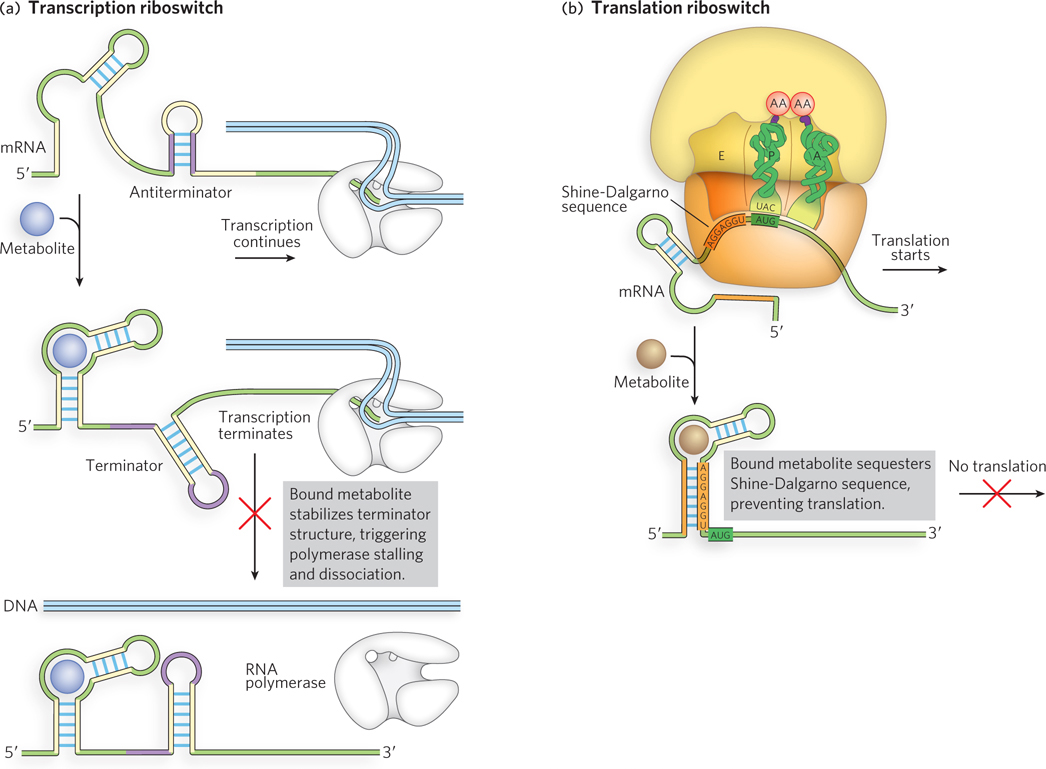
Figure 20-14: Riboswitches. Riboswitches are structures within an mRNA that bind metabolites (which act as ligands) and undergo a conformational change to regulate gene expression. Riboswitches exert their control at the level of (a) transcription or (b) translation.
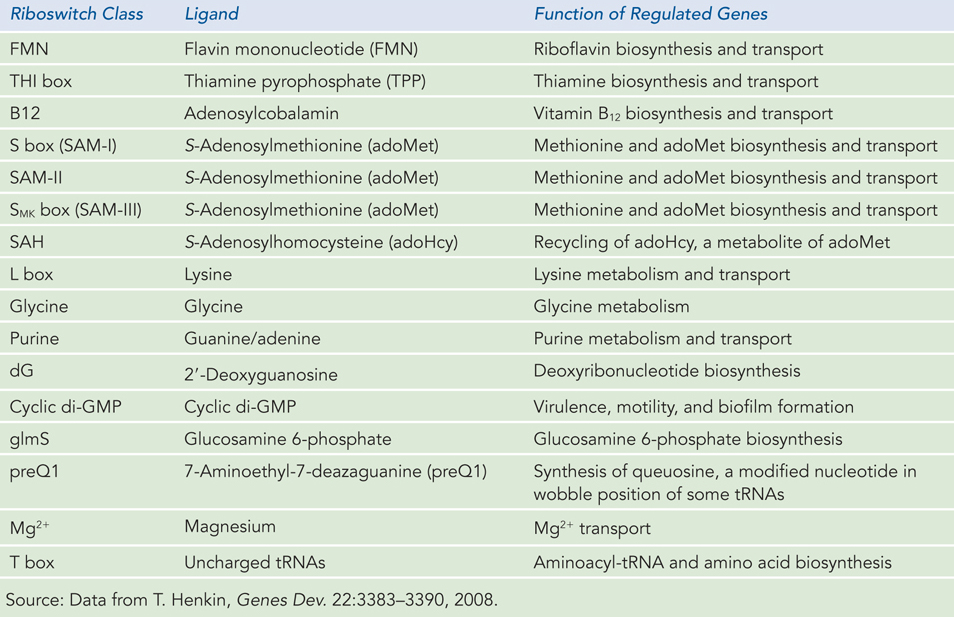
Figure 20-1: Types of Riboswitches
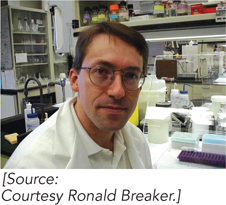
Ronald Breaker
The discovery of riboswitches led to questions about how they translate binding events into changes in gene expression levels. Ronald Breaker and his colleagues at Yale University carried out elegant experiments, in vitro and in vivo, to analyze what happens to an mRNA containing a riboswitch on exposure to a ligand. The researchers used chemicals and enzymes that cleave single-stranded, but not double-stranded, regions of RNA to digest riboswitch-containing transcripts (referred to simply as “riboswitch RNA”) in the presence or absence of ligand. By comparing the different patterns of RNA fragments generated with and without bound ligand, they found that riboswitches undergo conformational changes on binding to a favored ligand. Genetic experiments showed that mutations in these regulatory regions prevented changes in gene expression in response to changing levels of ligand. This led to the idea that riboswitch RNAs undergo structural rearrangements on binding to their target ligands, resulting in either transcription termination or sequestration of a Shine-Dalgarno sequence, thus preventing translation. Although these mechanisms are established for some riboswitches, other riboswitches may have different kinds of downstream effects stemming from their ability to undergo conformational change on binding a specific ligand.
More detailed insights have come from structural studies of the riboswitch RNAs, particularly by x-ray crystallography. To use this approach, large amounts of homogeneous RNA corresponding to the riboswitch must be purified and concentrated slowly in the presence of salts that favor crystallization. Several riboswitch structures determined in this way, in the presence or absence of a bound ligand, have revealed the nature and magnitude of the structural changes that occur on ligand binding. For example, the thiamine pyrophosphate (TPP)–binding riboswitch, located in the 5′UTR region of mRNAs involved in vitamin B1 (thiamine) biosynthesis, controls gene expression by inhibiting translation in the presence of abundant vitamin B1. This regulatory RNA region, also known as the THI box or THI element, is one of the few examples of a riboswitch found in all organisms—archaea, eukaryotes, and bacteria.
Like other riboswitches, the THI box adopts a globular structure that encircles the TPP ligand (Figure 20-15a). In the absence of TPP, this structure is not energetically favored. Evidence for this conclusion comes from experiments in which the TPP riboswitch RNA is incubated in a buffered solution with or without TPP, then subjected to ribonuclease cleavage. When TPP is present, ribonuclease cleaves the riboswitch RNA at only a few positions in the nucleotide sequence, but in the absence of TPP, most of the RNA is susceptible to cleavage (Figure 20-16). This result indicates that the three-dimensional structure of the riboswitch is stable only in the presence of the TPP ligand.
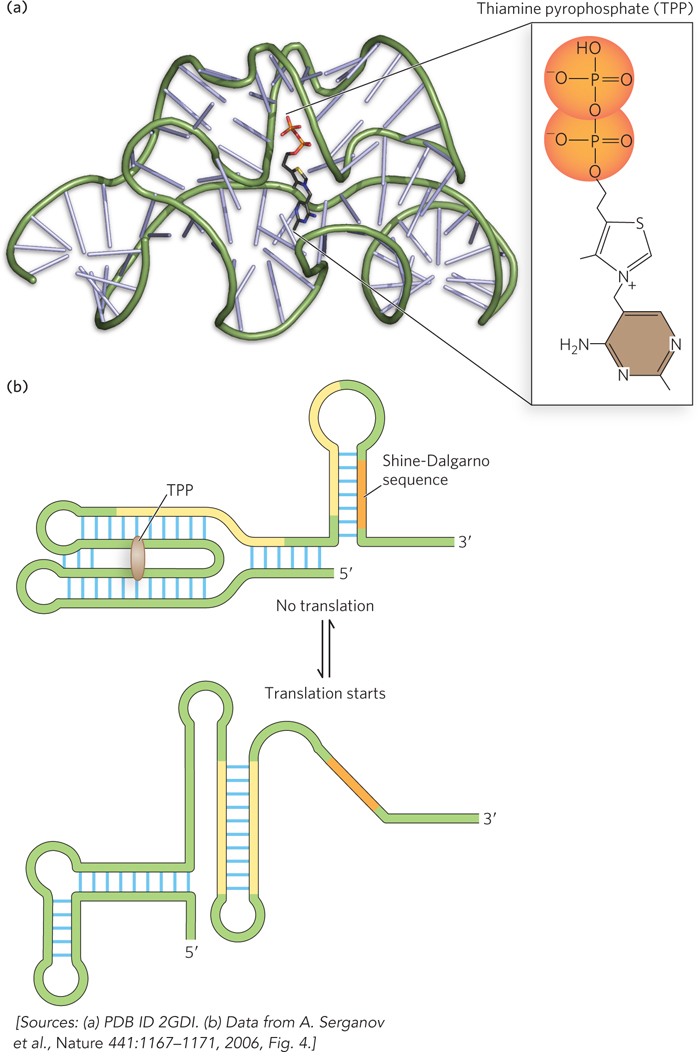
Figure 20-15: The TPP riboswitch. (a) Structure of the riboswitch RNA bound to its ligand, thiamine pyrophosphate (TPP). (b) Proposed mechanism of TPP riboswitch function. When bound to TPP, the riboswitch assumes a conformation that sequesters the Shine-Dalgarno sequence, preventing translation of the mRNA. Mg2+ ions (not shown) also play a role, allowing closer packing of the RNA helices and TPP. In the absence of TPP, an alternative secondary structure forms (yellow regions are complementary to and base-pair with each other), and translation can be initiated.
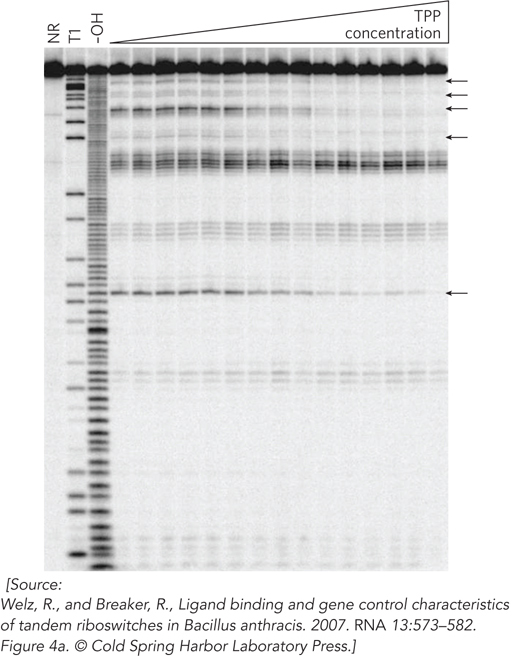
Figure 20-16: The effect of ligand binding on RNA susceptibility to spontaneous breakdown. In this experiment, a transcript containing just the TPP riboswitch aptamer sequence was incubated under slightly alkaline conditions in the presence of increasing concentrations of TPP. The leftmost lane (NR) of the polyacrylamide gel contains untreated RNA; the dark band indicates the size of the full-length RNA. The next two lanes show the fragments generated by partial digestion of the RNA with either riibonuclease T1 (T1) or strong alkali (-OH) in the absence of TPP. Many sites on the RNA are susceptible to cleavage when TPP is not present, indicating that the RNA does not form a stable three-dimensional structure. As the remaining lanes show, when the RNA is incubated for long periods of time under slightly alkaline conditions, fewer fragments are generated as the TPP concentration is increased (arrows). This demonstrates that TPP promotes formation of secondary and tertiary structures that protect certain residues from spontaneous cleavage.
This discovery immediately suggested a mechanism by which the TPP riboswitch could regulate gene expression. Inspection of sequences containing the THI box showed that it occurs near the gene’s Shine-Dalgarno sequence. When no TPP is present, the riboswitch structure does not form, or at least is unstable, and the Shine-Dalgarno sequence is accessible for ribosome binding. However, when TPP is abundant and the cell no longer needs to synthesize the enzymes required for vitamin B1 production, the riboswitch structure forms, and the Shine-Dalgarno sequence is no longer available to the ribosome. Examination of the TPP-bound form of the riboswitch shows how this works: TPP binds at the surface between two stem-and-loop structures in the RNA, creating a network of contacts between the small-molecule ligand (TPP) and the two RNA helices (Figure 20-15b). Nearby Mg2+ ions help neutralize the negative charges on the pyrophosphate group of the ligand, as well as the charges on the RNA phosphodiester backbone, allowing the TPP and the RNA helices to pack close together. This mode of binding, in which the structure of the ligand-recognition cavity forms only in the presence of its cognate ligand, is an example of induced fit (see Chapter 5).
To be useful as gene regulators, riboswitches must be able to distinguish between chemically related small molecules. Riboswitch RNAs prepared by in vitro transcription were found to bind much better to their natural ligand than to small molecules with similar but distinct chemical structures. Riboswitch RNAs can distinguish between molecules based on atomic charge, stereochemistry, and the presence or absence of particular functional groups.
Breaker and colleagues’ analysis of an interesting bacterial riboswitch that controls the gene glmS gives us an example of the specificity of riboswitches. This gene encodes an enzyme that catalyzes the conversion of fructose 6-phosphate and glutamine to glucosamine 6-phosphate—a metabolite that down-regulates glmS expression. The riboswitch, in the 5′UTR of the glmS mRNA, binds glucosamine 6-phosphate to form a catalytically active structure—a ribozyme—that cleaves the glmS mRNA and thus leads to its degradation (Figure 20-17a). Glucosamine 6-phosphate is a cofactor for the catalytic reaction and participates directly in the reaction chemistry. Experiments with different, structurally related sugars showed that sugars with even single-atom differences relative to glucosamine 6-phosphate could not support glmS ribozyme cleavage (Figure 20-17b, c).
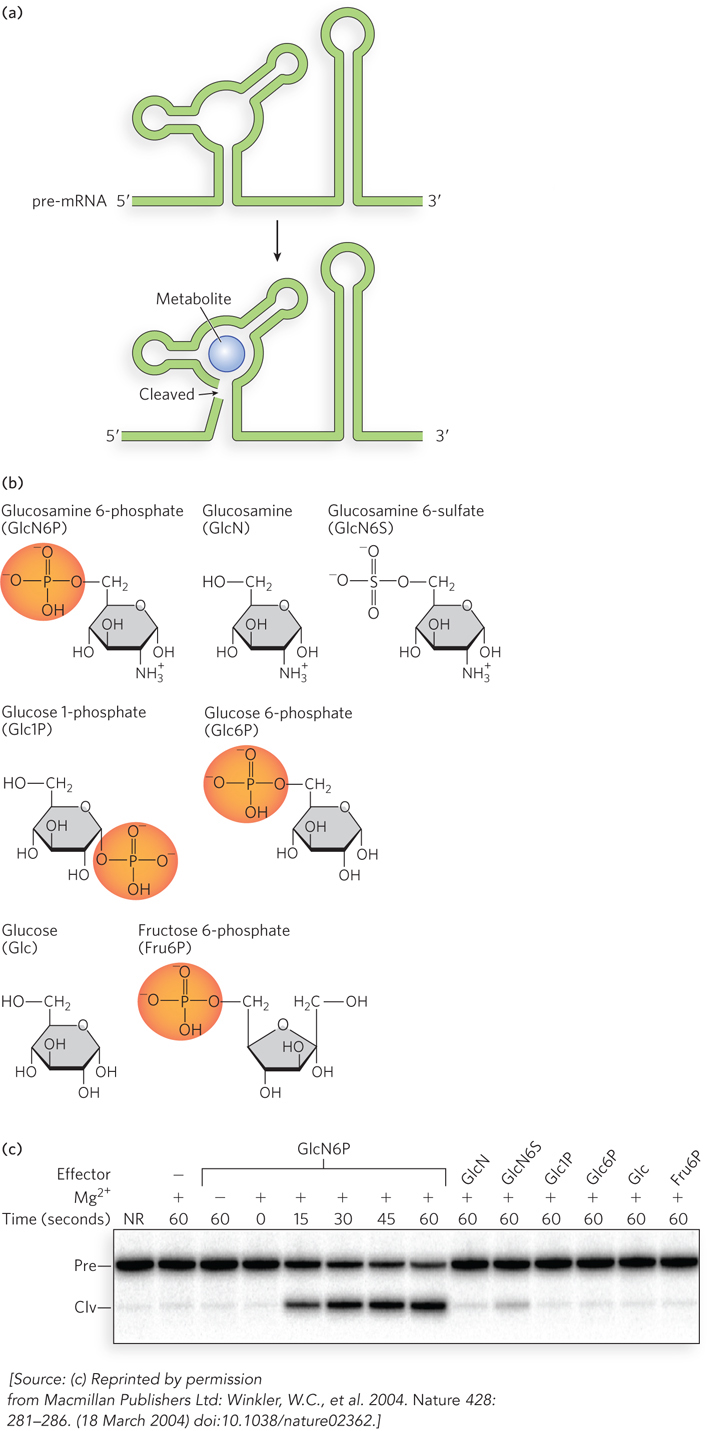
Figure 20-17: Ligand specificity in the glmS riboswitch. The glmS riboswitch is a ribozyme. (a) On binding of its small-molecule metabolite, glucosamine 6-phosphate, the glmS precursor mRNA (pre-mRNA) cleaves itself, promoting its own degradation. (b) The structure of glucosamine 6-phosphate (GlcN6P) and some close structural analogs. (c) Result of agarose gel electrophoresis of ribonuclease-cleaved samples. The glmS RNA was incubated with its known effector (GlcN6P) or with one of the other compounds shown in (b), for the times indicated. The leftmost lanes show untreated pre-mRNA (NR) and pre-mRNA incubated with no effector added (−). The top row of bands shows the full-length pre-mRNA (Pre); the bottom row, the ribonuclease cleavage product (Clv). Only GlcN6P induced cleavage of the pre-mRNA, indicating that the glmS riboswitch is highly specific for this ligand; the results also show that the riboswitch requires Mg2+.
Because the glmS ribozyme is active only when bound to glucosamine 6-phosphate, this system affords a simple but effective mechanism for reducing glmS transcript levels when the gene product is not needed, thereby preventing translation. Although this is the only known example of a ribozyme that uses a small-molecule cofactor as part of its catalytic mechanism, it suggests that ribozymes are inherently capable of such chemical collaborations and hence might be capable of more complex functions than have been discovered so far.
The glmS ribozyme has been crystallized in the precleaved and postcleaved states, as well as bound to its ligand. Unlike the TPP riboswitch, the glmS riboswitch was found to have essentially the same structure in all three states. Preformed catalytic and cofactor-binding sites may favor glucosamine 6-phosphate binding, enabling greater sensitivity to glucosamine 6-phosphate levels and hence to the metabolic state of the cell. Another notable feature of the glmS riboswitch structure is that the cofactor binds in an open, accessible pocket, perhaps further favoring ligand binding and ribozyme activation (see Figure 20-17a). How does glucosamine 6-phosphate participate in the ribozyme reaction chemistry? Although not yet confirmed, the crystal structures suggest that the amine group of the ligand may help to activate a specific 2′-hydroxyl group in the RNA backbone for nucleophilic attack.
Some riboswitches occur in similar types of genes and share common regulatory features. For example, levels of aminoacylated tRNAs in certain bacteria are controlled by RNA structures that respond to the concentration of specific amino acids in the cell (Highlight 20-2).
Although examples of riboswitches have been identified in all three domains of life—bacteria, archaea, and eukaryotes—they seem to be most common in the bacterial world, where they are employed in the regulation of genes involved in the biosynthesis of vitamins, enzyme cofactors, and various amino acids. What might be the reason for this greater frequency of riboswitches in bacterial cells? The use of RNA as a metabolite detector affords cells the opportunity to regulate gene expression without requiring the presence or synthesis of additional regulatory proteins. For microbes that must rapidly adjust to changing environmental conditions and availability of vitamins, enzyme cofactors, amino acids, and other small molecules, riboswitch mechanisms seem to be a highly suitable mode of regulation. However, these mechanisms may lack the multiple layers of regulatory control that are typically found in eukaryotic organisms, and they may not be sufficient to enable the kind of coordination and fine-tuning of gene expression required for such complex processes as development and organ differentiation (processes discussed in Chapter 22).
Translation of Ribosomal Proteins Is Coordinated with rRNA Synthesis
In bacteria, an increased cellular demand for protein synthesis is met by increasing the number of ribosomes, rather than increasing the activity of individual ribosomes. In general, the number of ribosomes rises as the cellular growth rate increases. At high growth rates, ribosomes make up about 45% of the bacterial cell’s dry weight. The proportion of cellular resources devoted to making ribosomes is so large, and the function of ribosomes so important, that bacteria must coordinate the synthesis of the ribosomal components: the ribosomal proteins (r-proteins) and RNAs (rRNAs). This regulation occurs largely at the level of synthesis of r-proteins.
HIGHLIGHT 20-2 A CLOSER LOOK: T-Box Riboswitches
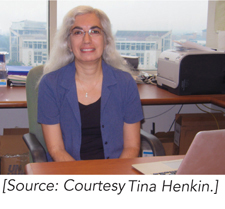
Tina Henkin
RNA molecules rather than proteins are sometimes employed by bacterial cells to detect the presence of small molecules. While studying how the soil bacterium Bacillus subtilis responds to environmental changes, Tina Henkin and her colleagues at the Ohio State University discovered that the tyrS gene transcript, which encodes tyrosyl-tRNA synthetase, includes an RNA structure in the noncoding leader region that monitors levels of tyrosine in the cell. Rather than the tyrS mRNA leader region binding directly to tyrosine, the limitation of tyrosine availability in the cell is detected by interaction of the leader region with uncharged tRNATyr. The anticodon of the tRNATyr base-pairs with a single detector “codon” in the mRNA leader, and the amino acid arm of the tRNATyr makes a second interaction with the leader, promoting RNA polymerase read-through of a structure that would otherwise cause transcription termination (Figure 1). In this way, the depletion of tyrosine, leading to increased levels of uncharged tRNATyr, enhances transcription of the mRNA encoding tyrosyl-tRNA synthetase, which in turn charges more tRNATyr to Tyr-tRNATyr. This mechanism is not unique to tyrosine: the leader regions of at least 18 aminoacyl-tRNA synthetase and amino acid biosynthetic gene transcripts in B. subtilis and related gram-positive bacteria have conserved structural features similar to those of the tyrS gene. An example is regulation of tryptophan levels by the anti-TRAP protein (see the How We Know section at the end of this chapter). Collectively, these RNAs are known as the T-box family of regulators, or T-box riboswitches.
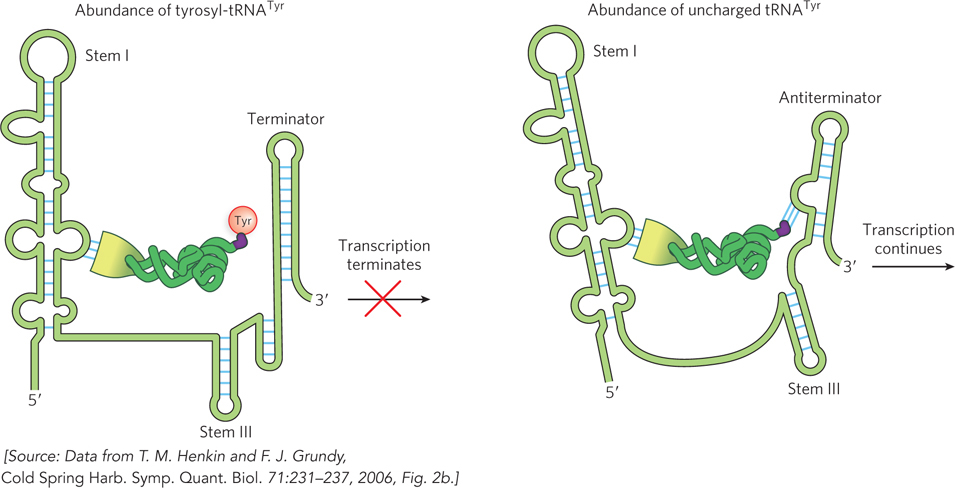
FIGURE 1 The tyrS riboswitch senses the cellular level of uncharged tRNATyr. Both charged and uncharged tRNATyr interact with the leader region of the mRNA at the detector codon, but only uncharged tRNATyr is capable of a second interaction between its amino acid arm and the antiterminator. This second interaction stabilizes the antiterminator and promotes continued transcription of the tyrosyl-tRNA synthetase gene.
Using genetic methods, Henkin and her colleagues found that mutations in these regulatory regions of the mRNA prevent or change the ability of the genes to respond to specific amino acid levels. For example, a change in the detector codon of the tyrS mRNA leader from UAC (which base-pairs with tRNATyr) to UUC (which base-pairs with tRNAPhe) resulted in loss of transcription induction by low tyrosine levels and a switch to induction by low phenylalanine levels. In contrast, insertion of an extra nucleotide immediately before the detector codon did not affect regulation. Because such an insertion would change the reading frame of the ribosome, this finding indicates that the regulation results directly from RNA-mediated structural changes, rather than requiring production of a protein. Ultimately, Henkin demonstrated that tyrS antitermination can occur in a purified transcription system with no additional cellular factors, indicating that the leader RNA is sufficient for specific recognition of the cognate tRNA. These findings were among the first hints that RNA molecules play broader roles in gene regulation than previously expected.
The 52 genes that encode the r-proteins occur in at least 20 operons, each containing 1 to 11 genes. Some of these operons also contain the genes for the subunits of DNA primase, RNA polymerase, and the elongation factors required for protein synthesis—revealing the close coupling of replication, transcription, and translation during bacterial cell growth.
The r-protein operons are regulated primarily through a translational feedback mechanism. One r-protein encoded by each operon also functions as a translational repressor, which binds the mRNA transcribed from that operon and blocks translation of all the genes encoded by the mRNA (Figure 20-18). In general, the r-protein that plays the role of repressor also binds directly to an rRNA. Each translational repressor r-protein binds with higher affinity to the appropriate rRNA than to its mRNA, so the mRNA is bound and translation is repressed only when the level of the r-protein exceeds that of the rRNA. This ensures that translation of the mRNAs encoding r-proteins is repressed only when synthesis of these r-proteins exceeds the level needed to make functional ribosomes. In this way, the rate of r-protein synthesis is kept in balance with rRNA availability.

Figure 20-18: Regulation of r-protein operons through a translational feedback loop. In many r-protein operons, such as the one shown here, one of the r-proteins produced by the operon (in this case, protein L4) also functions as a translational repressor in a mechanism that involves sensing the relative levels of r-proteins and rRNAs. L4 protein has a higher affinity for rRNA and binds it preferentially over the r-protein mRNA. When levels of r-protein are low relative to rRNA, few L4 protein molecules are available to bind the mRNA and translation proceeds, making more r-proteins. But when r-protein concentrations build up in excess of rRNA levels, the L4 protein binds to the mRNA generated from the operon and blocks production of additional r-proteins by preventing efficient initiation of translation.
The mRNA binding site for the translational repressor is near the start site of one gene in the r-protein operon, usually the first gene (see Figure 20-18). In other operons this would affect only that one gene, because in polycistronic mRNAs, most genes have independent translation signals. In r-protein operons, however, the translation of one gene depends on the translation of all the others. The mechanism of this translational coupling is not yet understood in detail. In some cases, the translation of multiple genes seems to be blocked by folding of the mRNA into an elaborate three-dimensional structure that is stabilized by both internal base pairing and binding of the translational repressor. When the repressor is absent, ribosome binding and translation of one or more genes disrupts the folded structure of the mRNA, allowing all the genes to be translated.
Because the synthesis of r-proteins is coordinated with the availability of rRNA, ribosome production reflects the regulation of rRNA synthesis. In E. coli, rRNA synthesis from the seven rRNA operons responds to cellular growth rate and to changes in the availability of crucial nutrients, particularly amino acids. The regulation that is coordinated with amino acid concentrations is known as the stringent response (Figure 20-19). It enables cells to direct resources away from growth and division and toward the biosynthesis of amino acids, to ensure survival until amino acid availability increases. The effects include down-regulation of rRNA and tRNA transcription. When amino acid concentrations are low, rRNA synthesis is halted. Amino acid starvation leads to the binding of uncharged tRNAs to the ribosomal A site, triggering a sequence of events that begins with the binding of an enzyme called stringent factor (RelA protein) to the ribosome. When bound to the ribosome, stringent factor catalyzes formation of the unusual nucleotide guanosine tetraphosphate (ppGpp). The enzyme adds pyrophosphate to the 3′ position of GTP, in the reaction:

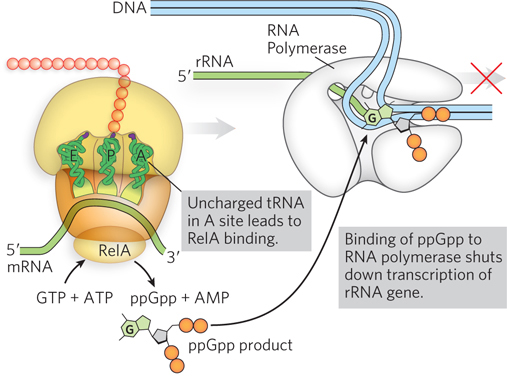
Figure 20-19: The stringent response in E. coli. Synthesis of rRNA from the seven rRNA operons is regulated by amino acid concentrations. When amino acid supplies are low, uncharged tRNAs can enter the ribosomal A site, triggering the stringent response and repressing rRNA synthesis. The formation of ppGpp occurs in two steps, as described in the text.
A phosphohydrolase then cleaves off one phosphate to form ppGpp. The abrupt rise in ppGpp concentration in response to amino acid starvation results in greatly reduced rRNA synthesis; this is mediated, at least in part, by the binding of ppGpp to RNA polymerase, blocking transcription of the rRNA genes.
Like cAMP, ppGpp belongs to a class of modified nucleotides that act as cellular second messengers (see Chapter 6). In E. coli, ppGpp and cAMP serve as starvation signals; they cause large changes in cellular metabolism by increasing or decreasing the transcription of hundreds of genes. Similar nucleotide second messengers also have multiple regulatory functions in eukaryotic cells. The coordination of cellular metabolism with cell growth is highly complex, and further regulatory mechanisms undoubtedly remain to be discovered.
SECTION 20.2 SUMMARY
Riboswitches regulate gene expression without the need for a separate regulatory protein, such as a repressor or an activator, to respond to signaling molecules. Direct binding of a riboswitch to a small-molecule ligand triggers a conformational change in the adjacent regulatory region that alters mRNA stability or translational efficiency.
Ribosomal protein operons are regulated primarily through a translational feedback mechanism. One r-protein encoded by each operon functions as a translational repressor by binding to the mRNA transcribed from that operon and blocking translation of all the genes it encodes.
In the stringent response, a starvation-induced pathway, the small signaling molecule ppGpp binds to RNA polymerase and reduces transcription of rRNA genes (and thus the number of ribosomes) and other genes needed for rapid growth.










